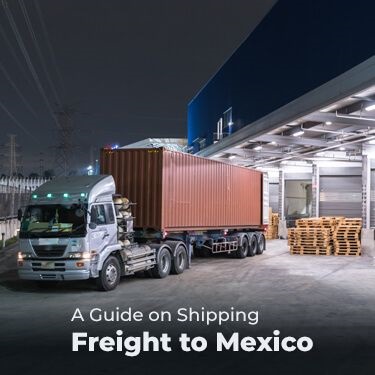
By
 Copy URL to Clipboard
Copy URL to Clipboard
As companies increasingly move their manufacturing operations to Mexico, understanding the intricacies of shipping freight south of the border has become crucial for seamless cross-border logistics.
Key Takeaways:
In this guide, I’ll walk you through the essential steps, required documentation, regulations, border crossing points, and tips for choosing a reliable freight shipping company.
Table of Contents
Shipping freight from the U.S. to Mexico involves several steps to ensure smooth and efficient transportation. Here's a detailed step-by-step guide:
Most of this guide is specific to truckload freight, but depending on your needs, you may find a different form of transportation suits you better.
Truckload freight is ideal for medium to large shipments that need to be delivered quickly and directly, especially given the extensive highway networks within North America.
Rail freight is suitable for bulk commodities and heavy goods, offering cost-effective long-distance shipping despite potential additional handling costs at terminals. Open deck trailers can be good for these commodities too.
For urgent or high-value shipments, air freight is often the best option, despite being more expensive. Sea freight is perfect for very large shipments or non-urgent goods, or goods entering internationally, not from the U.S. Ocean transport is a cost-effective solution albeit slower than other methods.
A customs broker is a licensed professional who assists with the complex customs clearance process. They handle all necessary documentation, ensuring accuracy and compliance with both U.S. and Mexican regulations, thus reducing the risk of delays or penalties.
While hiring a customs broker is not a requirement when freight shipping to Mexico, it is highly recommended. Shipping south of the border isn’t like shipping domestically. You will have to cross international lines, and that means clearing Customs and potentially dealing with a language barrier.
The last thing you want is to have any inaccuracies in your paperwork or misunderstand Mexican Customs regulations when attempting to clear your shipment. A customs broker can help avoid all of that.
When choosing a freight provider for your shipment into Mexico, you’ll want to opt for one experienced in trans border shipping.
Crossing the border means complying with additional transportation regulations, being licensed in multiple countries, and familiarity with additional customs and laws. Make sure you choose a provider that can handle each leg of the transportation process seamlessly.
Proper preparation of your shipment ensures it complies with regulations and arrives safely. Use appropriate packaging materials to protect goods and ensure that the packaging meets both U.S. and Mexican standards, also known as NOMs (Normas Oficiales Mexicanas).
Clearly label each package with essential information, including contents, destination address, and handling instructions. Attach necessary documents such as the commercial invoice, packing list, and bill of lading to the shipment. Ensuring that all of this information matches is crucial to clearing your shipment.
Coordinate with your chosen freight shipping company to arrange for the pickup of your goods from the origin point and delivery to the destination in Mexico.
Plan the pickup time to ensure it aligns with your production schedule and ensure the delivery timeline meets your business needs, taking into account any potential delays at the border.

Once your shipment is on its way, it’s going to have to clear the U.S.-Mexico border. Depending on your freight and the provider you choose, the cargo will either remain in the trailer all the way through, or it could have to be dropped off at a nearby facility and transferred into a new trailer/container for the remainder of the journey.
Once that is decided, both U.S. and Mexican customs officials will inspect the cargo and paperwork, potentially breaking its seal. Once approved, your shipment will be cleared for transportation to its final destination.
Shipping freight across international borders requires careful attention to the necessary documentation, and just because Mexico is so close to home doesn’t make the paperwork any simpler.
You must ensure that the following documents are filled out accurately and submitted on time to ensure a seamless and penalty-free shipping process.
Understanding the key border crossing points can streamline your shipping process. While there are many places your shipment could cross into Mexico, the one your truck will go through will largely depend on:
Many of the most notable border crossings between the U.S. and Mexico are equipped with facilities to handle large volumes of freight efficiently:
Some border crossings offer pre-inspection programs that expedite the clearance process, such as the:

This probably goes without saying, but when selecting a freight shipping company for shipments in and out of Mexico, prioritize those with extensive experience in cross-border shipping.
Generally speaking, a 3PL provider will be your best bet. They can handle the shipping, customs clearance, and any additional warehousing or logistics needs on your behalf. Choosing one company that can handle each link in the supply chain allows for a far more seamless and transparent process, especially for cross border shipments.
Make sure the company can accurately track and manage shipments, providing real-time updates on the status and location of your freight. Automated alerts for delays or issues will help you proactively manage the shipping process.
And make sure you assess the company's reputation before choosing. Don't hesitate to ask for references from other businesses in your industry to ensure you choose a trustworthy partner.
Shipping freight to Mexico involves careful planning, compliance with regulations, and choosing the right partners. Thankfully, that’s where Mexico Cross Border Freight can help.
Powered by R+L Global Logistics, we can handle all of your freight and supply chain needs into, out of, and within Mexico. From transportation to customs brokerage, we’re here to make the process as simple and seamless as possible.
Ready to get started? Give us a call at (866) 335-0495 or fill out one of our quote forms and speak to one of our logistics experts today.
 Copy URL to Clipboard
Copy URL to Clipboard
